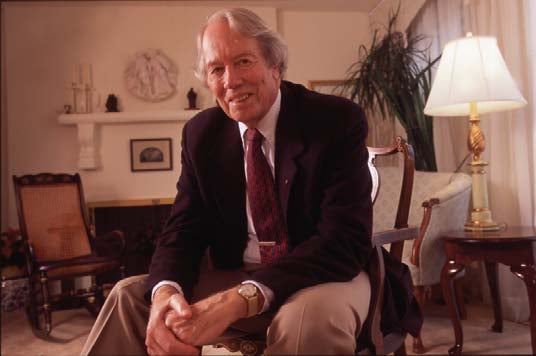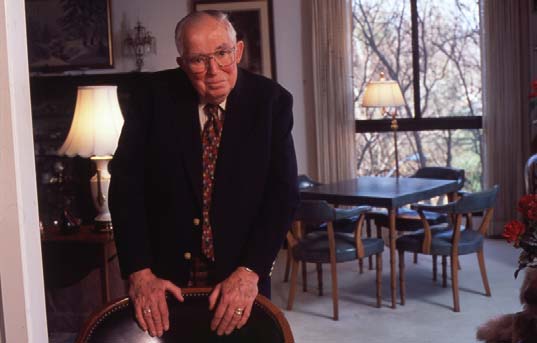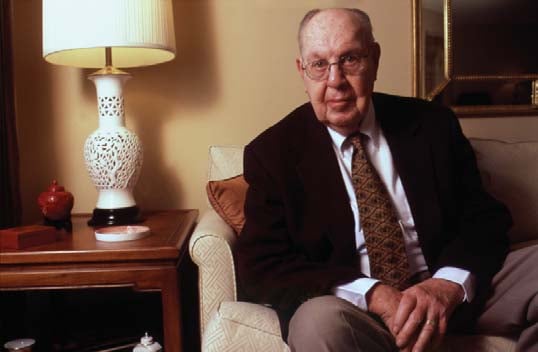Profiles of three individuals who are putting their admiration into action to benefit the Whiting School
Charitable gifts to the Whiting School of Engineering come in all shapes and sizes—and for all different reasons. But at the heart of each contribution is a strong admiration for the School and its devoted faculty and students who continue to expand the boundaries of engineering knowledge.
There are myriad ways to give to the Whiting School— among them, cash, securities, real estate, and equipment. Based on their financial objectives, donors may choose to make an outright gift or defer their contribution in a life-income gift, such as a charitable remainder unitrust or a charitable gift annuity. Many choose to celebrate a 65th, 60th or other special class reunion at Hopkins by making an especially generous planned gift.
A life-income gift combines philanthropy to the Whiting School with an income stream for the donor or one or more designated beneficiaries, and also provides opportunities for significant tax savings. According to Bernard J. “B.J.” Davisson II, senior director of gift planning at the Johns Hopkins University, donors are pleased—and often quite surprised—to learn that life-income gifts provide the personal satisfaction of supporting one’s alma mater while also offering a sense of security and attractive tax advantages.
In their discussions with donors, Davisson and his staff emphasize that charitable contributions are not meant to be onesize- fits-all. “I look at charitable giving—in particular, making a life-income gift—as a creative process that adapts to the changing needs and wishes of each individual donor,” Davisson says. “It’s not just about what Hopkins gets. It’s about what works best for donors in terms of meeting their objectives and obtaining the most favorable tax benefits.”
<br\>
<br\>
Ted Schad ’39:
A Rational Approach in Environmental Management

“I’ve always felt that I owe my career largely to Johns Hopkins and the opportunity to work with Abel Wolman.” Theodore M. Schad ’39
Theodore M. “Ted” Schad ’39 spent 50 years working to improve this country’s water resource management— and he’s not finished yet. Now retired and living in Arlington, Virginia, Schad wants to ensure that others will continue the work to which he devoted his pro– fessional career. That’s why his planned gift will establish the Theodore M. and Kay W. Schad Environmental Management Fund in the Department of Geography and Environmental Engineering (DoGEE) at the Whiting School. The fund will be created through Schad’s charitable remainder unitrusts, with values now approaching $2 million.
“I want Johns Hopkins to continue the work I was trying to do,” Schad states. “The water problems we face today are the same ones we were worried about 30 to 50 years ago. We’ve known what to do, but you can’t take the politics out of water management,” he reflects. “That’s why I envision someone at Hopkins who is like Abel Wolman—who was very involved in government policy—to use this professorship to get things done rationally in this field.”
Abel Wolman ’13 A&S, ’15 became one of the Whiting School’s most revered alumni and faculty members (see www.wse.jhu.edu/JH_Engineer for a profile). Hailed internationally as the father of clean water, Wolman was a legendary figure in Engineering at Hopkins from its beginnings in World War I until his death in 1989 at the age of 96. He and three classmates formed the first Engineering class, graduating in 1915. He served as department chair and also as mentor to many students who later became influential around the world in environmental engineering. Among them was Schad, one of Wolman’s first student assistants. A lifelong friendship developed between the two men and, throughout Schad’s career, he often consulted with Wolman. “He was always right there for me,” recalls Schad, whose gratitude led him to support the Abel Wolman Fellowship Fund in the Whiting School.
“No one would be more pleased about Ted Schad’s giving than my dad,” explains M. Gordon “Reds” Wolman ’49, who serves as director of the Division of Environmental Health Engineering in the Bloomberg School of Public Health and also holds a faculty position in DoGEE. “Abel Wolman treasured his friendship with Ted, who is not only a fine human being, but also a firstrate engineer whose devotion to achieving intelligent water management policies clearly exemplified one of my dad’s aspirations for graduates of the department.”
Schad reflects, “I’ve always felt that I owe my career largely to Johns Hopkins and the opportunity to work with Abel Wolman.” And what a career it’s been. A Civil Engineering graduate, Schad is best known for his work as staff director of the U.S. Senate Select Committee on National Water Resources and as executive director of the National Water Commission. His 34-year career with the federal government included service with the U.S. Army Corps of Engineers, the Bureau of Reclamation, and the Bureau of the Budget. With the National Academy of Sciences/National Research Council, he served successively as executive secretary of the Environmental Studies Board and deputy executive director of the Commission on Natural Resources. In his private consulting as well, Schad has continued to make contributions to the development and analysis of U.S. water resource policy.
Although Schad’s civil service career wasn’t financially lucrative, Schad invested wisely and—when his second daughter completed college in 1980— decided the time was right to “pay something back” to the Whiting School. He researched charitable remainder unitrusts and liked what he learned.
“The charitable remainder unitrust was an opportunity to have my cake and eat it too,” Schad says with a chuckle. “I could take low-income-producing securities that had high capital gains and convert them to a steady stream of income.” Unitrusts, which can be an excellent vehicle to escape a “locked-in” stock position, can prove to be extremely valuable in the volatile markets of recent years. Tax advantages of a unitrust are often substantial, with the donor allowed a charitable deduction that is a percentage of the amount funding the trust. This deduction is based on the fair-market value of the asset transferred, the payout rate chosen, and either the age and number of beneficiaries or the term of years.
For Schad, whose wife, Kay, had been diagnosed with a brain tumor in the mid-1980s, the two-life unitrust’s guaranteed income provided peace of mind. He knew the income would supplement the funds for his wife’s medical care, should something happen to him. Just a few years later, Schad established two-life unitrusts for his two daughters. The income goes to Schad and then, upon his death, to his daughters to ensure income for their retirement. Upon their death, the unitrusts are transferred to the Whiting School.
In 1989, Kay passed away; they had been married 45 years. Shortly before her death, Schad was looking for additional ways to achieve his goals as well as to reduce taxes. So he made an outright gift to the Whiting School with the transfer of $35,000 in stocks. This gift established the Theodore M. and Kay W. Schad Environmental Management Fund in DoGEE to finance lectures in environmental management. When Schad eventually remarried, he and his present wife, Margot Cornwell, chose to fund another two-life unitrust, drawing the minimum income of 5 percent.
“The key point in making life-income gifts is that it doesn’t cost so much, once you count the benefits of capital gains tax avoidance, charitable income tax deductions, and the income your gift can provide you,” Schad explains. “When you offset that against the cost of the gift, it makes it quite affordable.”
Gordon Holland ’43:
The Right Tools for Materials Testing

“This charitable gift annuity will be something I look back on, knowing I did the right thing.” Gordon Holland ’43
Like Ted Schad, Gordon Holland ’43 gave careful consideration to making a life-income gift to the Whiting School. “Making a gift to my alma mater was first and paramount,” the Baltimore resident explains. “I wanted to repay the School of Engineering in a small way for what they did for me.”
Holland, who majored in Mechanical Engineering, credits his time at the Whiting School for his successful career. After graduation, he spent much of his professional life as a manufacturer’s agent with Yarrington and Johns, Inc., selling material handling equipment to Baltimore manufacturing companies. He also designed specialized equipment and coordinated plant layout.
After evaluating the tax advantages of different types of life-income gifts, Holland decided upon a charitable gift annuity. At the time, his wife, Anne, was receiving hospital care, with medical bills averaging $6,000 a month. The regular, reliable income from a gift annuity would have supplemented funds for her care if Holland had preceded her in death.
As Holland discovered, a charitable gift annuity is among the oldest, simplest, and most popular of the charitable lifeincome plans. In exchange for a transfer of assets, the donor (and/or another beneficiary) receives guaranteed quarterly or annual payments. Rates of return, which are recommended by the American Council on Gift Annuities, are typically higher than earnings from most conventional investments. Current rates range from 5.7 percent to 11.3 percent, depending on the gift amount and the age of the donor and/or beneficiary.
Other advantages of gift annuities include the ability to take an immediate charitable tax deduction, based on the assessed value of the gift over time, and favorable capital gains treatment. Many married donors, like Holland, appreciate the ability to structure the annuity to provide income throughout a spouse’s lifetime. As with other life-income gifts, once the annuity payments begin, they are guaranteed to continue for the life of the donors.
Holland found the staff at the Whiting School and the Hopkins Office of Planned Giving to be most helpful in guiding him through the gift process. “They did everything they promised to do,” he says. “All of them were wonderful to work with.” As staff members recommend to all donors, they encouraged Holland to consult with his own tax and legal advisors to determine how charitable giving would impact his financial well-being, now and in the future. “When I talked to my accountant about setting up a gift annuity with Hopkins, she said it was the smartest thing she’d ever heard of,” he recalls.
“This charitable gift annuity,” Holland continues, “will be something I look back on, knowing I did the right thing.” His $400,000 annuity to the Department of Mechanical Engineering will be used to establish the Gordon M. and Anne M. Holland Endowed Equipment Fund. This fund will provide income to support the maintenance, upgrade, and purchase of equipment used for materials testing in the Holland Laboratory.
The equipment connection is a perfect fit for Holland, who lives within walking distance of the Homewood campus and makes frequent visits when he’s not pursuing his love of travel.
It seems that engineering just might be in his family’s bloodline. Holland’s grandson is also an engineer. His brother, Donald ’43, earned a degree in Electrical Engineering. And his two nephews also studied engineering at Hopkins: Richard Holland ’54 and Robert Holland, who earned two degrees (a 1959 degree in Engineering through the part-time program and a 1964 bachelor’s degree from what is now the School of Professional Studies in Business and Education).
Charlie Miller ’40 A&S:
A Lab, a Professorship, an Award, and Volunteering All Attest to His Loyalty

“I’ve been doing engineering most of my life.” Charles M. Miller Jr. ’40 A&S, who took Chemical Engineering courses as a Hopkins student.
Engineering is near and dear to the heart of Charles A. Miller Jr. ’40 A&S, even though he graduated with a degree in Geology. Miller began at Hopkins as a Chemical Engineering student and worked in engineering all his life. Before coming to Hopkins, Miller had already fulfilled many of his academic requirements at Baltimore Polytechnic Institute. His advisor recommended taking geology as an elective; Miller did so, and loved it.
After graduation, Miller served in the Navy, retiring as a commander, and did not continue with his plans for graduate work in geology. Instead, he and two acquaintances launched the Industrial Products Company, which led to the 1956 founding of the Filterite Corporation, a Baltimore-based manufacturer of a diverse line of filtration equipment. He remained with Filterite until 1978, serving as president and chairman of the board even after the company was sold to the Brunswick Corporation.
“I’ve been doing engineering most of my life,” reflects Miller, who wasn’t at all surprised in 1985 when Johns Hopkins President Steven Muller (now president emeritus) asked for his help in strengthening the Mechanical Engineering department at Hopkins. “I wanted to give where the need was the greatest,” Miller explains.
Almost 20 years later, Miller’s generous gifts continue to benefit the Whiting School. He has funded the Charles A. Miller Jr. Undergraduate Laboratory of Mechanical Engineering in Latrobe Hall and, in 1994, established a $2 million bequest to fund the Charles A. Miller Jr. Distinguished Professorship in Mechanical Engineering.
But Miller didn’t want his alma mater to wait until his death to reap the rewards of his generosity. For a number of years, he has been making annual $75,000 payments to the School to fund the Miller Distinguished Professor endowment and to provide support for its inaugural holder, Andrea Prosperetti. An internationally known fluid dynamics researcher, Prosperetti mentors many doctoral students. “A chair enables you to take risks, to do exploratory research without having to rely only on grants,” Prosperetti has noted about Miller’s thoughtful support.
Says Miller, “My general feeling was that I’d just as soon give it now if I could. At least if I don’t like what goes on, I can do something about it,” he quips. “And if it’s something I 30 JOHNS HOPKINS ENGINEER SUMMER 2004 like, I can increase my giving. This way, I have some control.”
Miller also sponsors the Charles A. Miller Jr. Award, presented at Convocation to the outstanding Mechanical Engineering junior or senior. Miller, who lives in Towson, has yet to miss a Convocation.
He has given generously of his time as well, serving on the National Development Committee and using his many community connections to bring other alumni on board. From 1996 to 2002, Miller served as the inaugural chair of the Whiting Legacy Circle, which recognizes the individuals who have included Hopkins Engineering in their estate plans or made planned gifts through trusts, annuities, pooled income funds, and other deferred vehicles.
Laying the Groundwork
Comments Andrew S. Douglas, interim dean of Engineering, “All who’ve made a planned gift to the Whiting School—Gordon Holland, Charlie Miller, Ted Schad, and so many others— have demonstrated their love of this institution and of the engineering field. Beyond that, they’ve also helped us lay the groundwork for a strong and successful future as a world-class research university that attracts top-level students. I am so very grateful for the support of these generous alumni and hope that others will follow their fine example of philanthropy.”
For more information on how to make planned and estate gifts to the Whiting School, contact Associate Dean Michael Moyer at (410) 516-8723 or [email protected]




